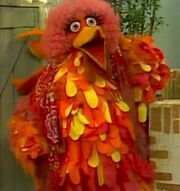Template:Performer

La Gallina Caponata
La Gallina Caponata (Caponata, the Chicken) is a muppet from the Spanish version of Sesame Street, having appeared from 1979 to 1980.
A big, human-sized muppet, Caponata is a yellow bird, supposedly intended to be a (female) chicken although any similitude to a chicken might be a coincidence. Caponata's sex is unclear on its , although the word gallina is clearly female in Spanish.
However, similitudes abound between Caponata and international Big Bird. Besides the different name, Caponata is yellow as Big Bird is, and is quite similar to Big Bird in personality: A 4-or-6-year-old helping children to learn and to feel okay about not knowing everything. She is a contrast with wise snail Perezgil.
Caponata differs from Big Bird in that she is quite less talented than him. Caponata does not skate, ride or dance (mainly because Caponata's puppetteer Emma Cohen might be less comfortable than Big Bird's Caroll Spinney).
Caponata also interacts with human characters, being the main muppet in the Spain-filmed scenes. She was friends with the likes of Adela, Petri and Julián, who seemed not to care about Caponata being a bird.
Behind the Scenes
The word caponata refers to a little-known Italian dish, similar to Greek moussaka. Spanish audience (even adult audience) is unfamiliar with this fact, and the word caponata usually refers to the muppet.
Although this is unconfirmed, apparently the puppetery on Caponata was similar to Big Bird's.
Spanish audience was initially confused with Big Bird's appearances on muppet movies such as Follow That Bird; Big Bird was confused with Caponata although his name had been translated as Paco Pico (Fred Beak, but notice the alliteration).
Caponata's eggs
Caponata's popularity was such that her name was used in a song by Los Payasos de la Tele, a group of TV clowns completely unrelated with the Henson factory, but who had reached an agreement with the Spanish owners of Caponata trademark. The song intended to teach children to count from one to ten:
La gallina Caponata ha puesto un huevo, ha puesto dos, ha puesto tres
La gallina Caponata ha puesto cuatro, ha puesto cinco, ha puesto seis
La gallina Caponata ha puesto siete, ha puesto ocho, ha puesto nueve
Déjale a la gallinita, déjale a la pobrecita, déjala que ponga diez
(Translation:)
Chicken Caponata has laid one egg, has laid two (eggs), has laid three (eggs)
Chicken Caponata has laid four (eggs), has laid five (eggs), has laid six (eggs)
Chicken Caponata has laid seven (eggs), has laid eight (eggs), has laid nine (eggs)
(Please) Let the little chicken, (please) let the little poor thing, (please) let her lay ten (eggs)
The song was increasingly popular, strangely, during the early 1980s, during Los Payasos's peak of popularity, sometimes even with a child audience who could not remember Caponata.
